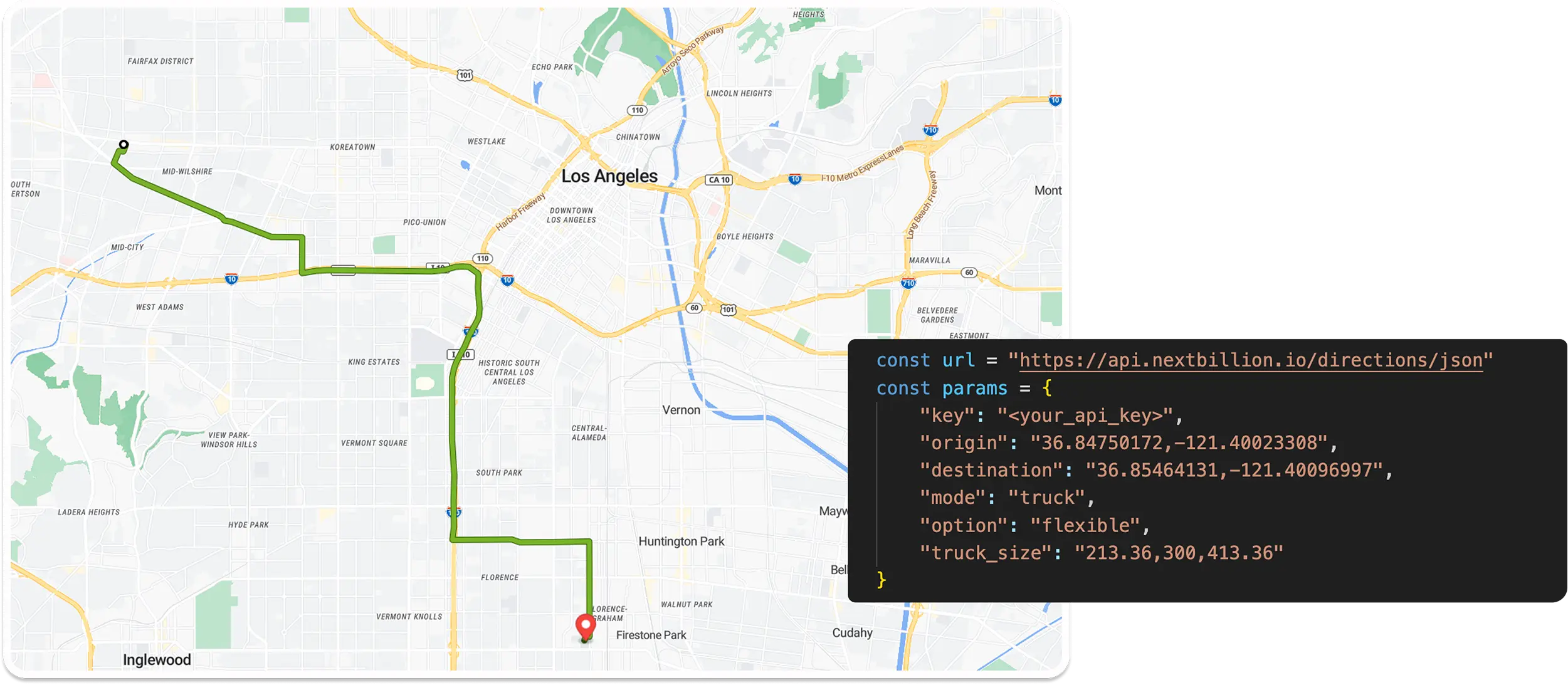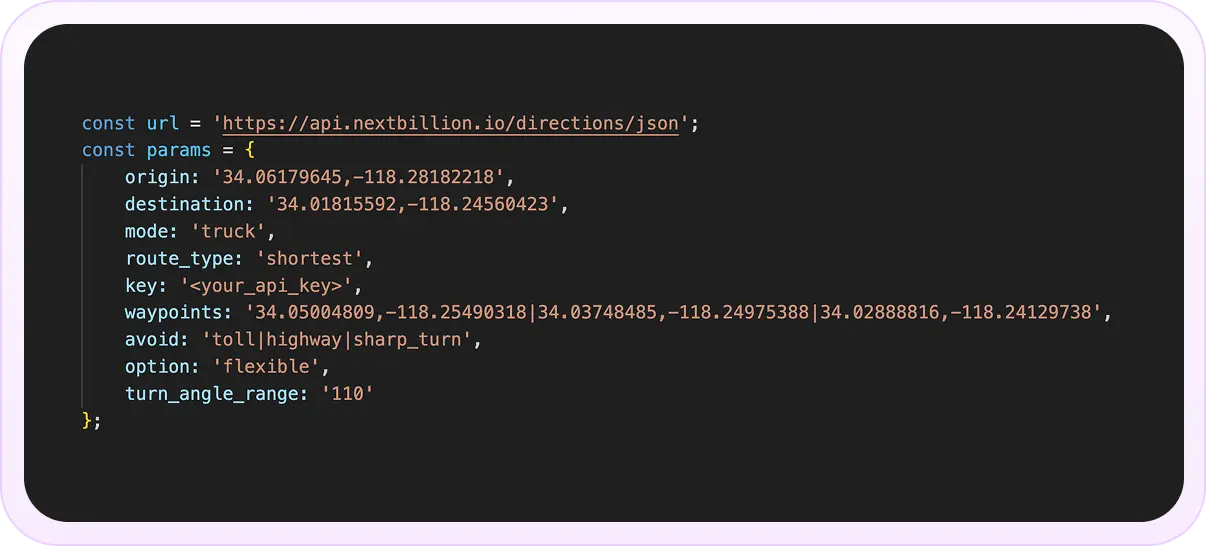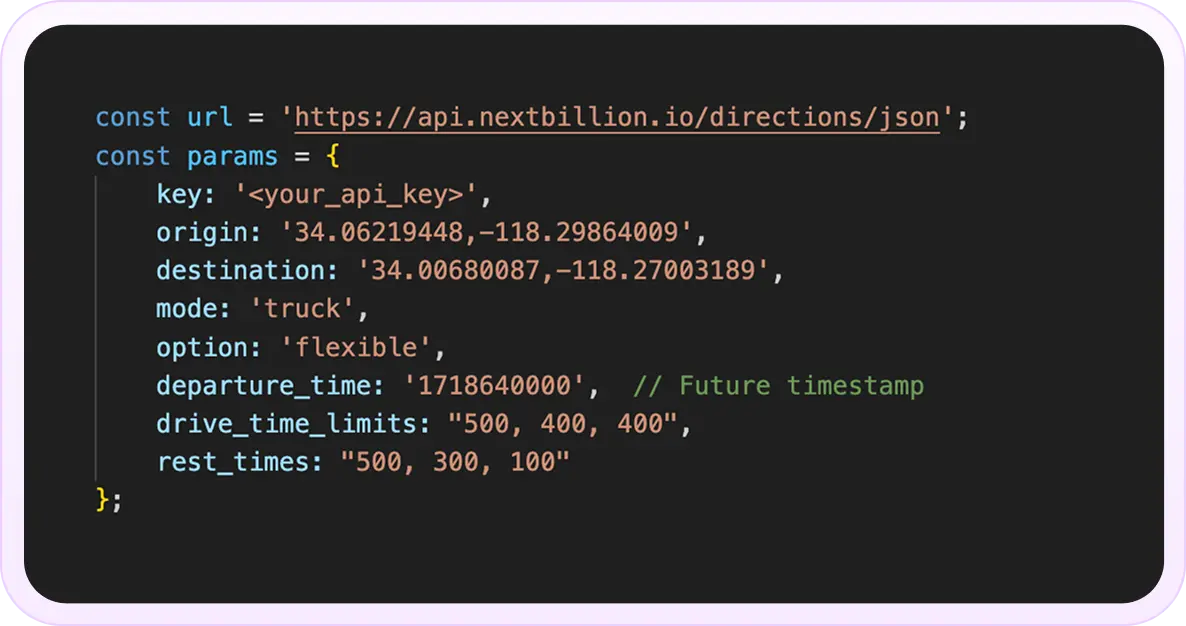

- BLOG
Integrating Directions API with Enterprise TMS Platforms (SAP TM/Oracle SCM)
Published: October 15, 2025
Route Optimization API
Optimize routing, task allocation and dispatch
Distance Matrix API
Calculate accurate ETAs, distances and directions
Directions API
Compute routes between two locations
Driver Assignment API
Assign the best driver for every order
Routing & Dispatch App
Plan optimized routes with 50+ Constraints
Product Demos
See NextBillion.ai APIs & SDKs In action
AI Route Optimization
Learns from Your Fleet’s Past Performance
Platform Overview
Learn about how Nextbillion.ai's platform is designed
Road Editor App
Private Routing Preferences For Custom Routing
On-Premise Deployments
Take Full Control of Your Maps and Routing
Trucking
Get regulation-compliant truck routes
Fleet Management
Solve fleet tracking, routing and navigation
Middle Mile Delivery
Optimized supply chain routes
Construction
Routes for Construction Material Delivery
Oil & Gas
Safe & Compliant Routing
Food & Beverage
Plan deliveries of refrigerated goods with regular shipments
Table of Contents

What if the “perfect route” you planned on paper could adapt instantly to traffic jams, weather disruptions, and real-world roadblocks? For supply chain managers, the gap between planning and execution is always there. A transportation management system can plan the perfect route on paper. But once the truck starts its journey on real roads, things change.
The transportation management system(TMS) market is booming. It is set to grow from USD 18,503.2 million in 2025 to USD 37,036.8 million by 2030, with a CAGR of 14.9%. This growth also increases the demand for smarter tools. Companies seek advanced tools to address real-world challenges, as logistics account for approximately 30% of the overall work in firms. That is where the Directions API comes in. It closes the gap between planned routes in platforms like SAP TM or Oracle SCM and what drivers actually face on the road.
In this blog, we will explore how TMS integration with the Directions API is changing enterprise logistics.

Directions API is a routing service which calculates optimum routes between two or more destinations. In addition to offering the origin-destination pointing, it uses road network data, traffic flow, and routing algorithms to suggest the most efficient route to the drivers. Although the API encourages driving, walking, cycling, and public transport, in enterprise logistics, driving optimization is the most commonly used application.
In case of logistics operations, the Directions API is capable of:
The API includes several parameters: time, distance, traffic flow, and road geometry, to generate routes that consider the speed, price, and feasibility. This renders routing not only theoretical but also executable in the field directly. This is vital to the logistics teams since the choice of route directly determines the fuel consumption, number of hours that the driver makes, and the costs incurred in general.
The Directions API connects with such applications as SAP Transportation Management (SAP TM) or Oracle Supply Chain Management (Oracle SCM), so drivers and dispatchers can always be oriented with fresh, real-time navigation instructions. Enterprises can no longer rely on fixed plans, which are now replaced by a dynamic routing system that adjusts to real-life conditions and keeps the trucks in motion and deliveries on time.
In brief, integration of the Directions API and enterprise TMS systems transforms routing plans into cost-effective action plans that can be scaled to operate in complicated logistics networks.

A recent Gartner study found that companies using an API-connected TMS saw a 27% boost in productivity. Not only this, but they experienced a 23% cut in costs. Here are a few more reasons why most enterprise TMS platforms like SAP TM or Oracle SCM are integrating Directions API:
Late deliveries during logistics are contributed most of the time by path deviation. When drivers rely only on the static directions given on the routes or using old maps, they might end up in the wrong direction, hence wastage of fuel, time, and manpower.
Directions API also addresses this risk by giving live route directions that can respond to road changes, live traffic, and road blockages. This also makes sure that the drivers are on the right course, not taking unnecessary tours, and not compromising the delivery time.
Violation of sequence occurs when delivery stops are not observed in the sequence given. To illustrate, when the sequence is set up to be House A → House B → House C and the driver drives House B → House A → House C, it causes inefficiencies, customer confusion, and downstream scheduling disruption.
With dynamic sequencing logic, Directions API imposes the right stop sequence, so every delivery is in accordance with the maximum plans. This feature is particularly important in multi-drop routes in last-mile logistics and urban delivery networks, where the efficiency of sequencing has a direct influence on the delivery time windows and customer satisfaction.
On-time delivery, as one of the key performance indicators (KPI), has a direct impact on customer trust and business development. The Directions API will improve time management by constantly informing drivers of their location in terms of road jamming, accidents, construction, or road closures.
Real-time alternative routing to drivers is provided, and they can avoid delays and arrive within delivery windows. The feature is applicable to marine logistics systems by using it along with the Fleet Optimization API to get multimodal synchronization of vessels, trucks, and inland cars.
Efficiency in logistics operations refers to the proficiency to deliver products with the minimum amount of wasted resources and the maximum output. Combining real-time routing APIs with enterprise-level TMSs can help companies decrease errors, including missed turns, ineffective detours, and sequence violations.
This results in quantifiable fuel savings, driver time savings, and vehicle maintenance savings, and allows drivers to make more stops per shift. In the long run, these benefits multiply, enhancing fleet utilization, reducing carbon emissions, and improving the overall resilience of the supply chain.
Combining Directions API with commercial TMS platforms like SAP TM or Oracle SCM involves gigantic enhancements. It enriches the efficiency of operations and also simplifies it to manage cost as well as supply chain performance. In fact, the integration simplifies it with various advantages:

Businesses that use multi-stop routes cannot work effectively without the capability of dynamic routing. The Directions API re-calculates and re-routes directions as they are utilized in real time and considers traffic congestion, weather, and road restrictions, including accident alerts.
The API makes sure that drivers take the most efficient route on the way to the planned number of stops, yet the order in the planned sequence in the Transportation Management System (TMS) should still be taken into consideration. This eliminates downtime, costs, and avoids needless detouring, as well as ensuring efficient utilization of fleets on both urban and long-haul networks.
Advantages:

The Directions API can be integrated into enterprise TMS systems to provide access to real-time, dynamic route optimization. The API also recalibrates routes as drivers head out on the road rather than using fixed routes that are calculated days beforehand. It considers traffic patterns, weather delays, infrastructure constraints, and delivery priority. Dynamic routing has been found to reduce route deviations by up to 40 percent, resulting in high operational efficiency and speed of delivery.
Advantages:
One of the largest KPIs in the field of logistics is on-time delivery performance. Directions API with TMS is used to avoid violation of sequence through providing turn-by-turn instructions to the driver according to the scheduled orders of stops. This provides punctuality of service, reduces the fines of late deliveries, and improves predictability of SLAs (Service Level Agreements). In such business domains as e-commerce or just-in-time manufacturing, this accuracy is directly related to customer satisfaction and business risk mitigation.
Advantages:
Directions API allows logistics managers to track operations more than ever before. With real-time route and vehicle data input in the TMS, managers can access accurate ETAs, live traffic status, and driver location in real time. The problem of road closures, port congestion, or weather-related issues can be addressed in advance. This develops a proactive logistics environment in which exceptions are dealt with quicker rather than in a reactive manner.
Advantages:
One of the biggest cost elements of logistics is fuel. The optimization of Directions API reduces wasted movements, detouring, and vehicle idle time. The route and dispatch messaging features automate updates to the drivers, while requiring less administrative support on the planner side. This reduces direct fuel and maintenance expenses, as well as enhancing sustainability through minimization of carbon emissions from logistics fleets.
Advantages:
The Directions API, when added to enterprise TMS systems, automates the route planning, dispatch, and navigation cycle. The system receives automatic updates which minimize human errors and ensure high data accuracy in reporting, billing, and compliance processes. This standardization enhances transparency and accountability in logistics operations and allows predictive analytics to be used in future planning.
Advantages:
Logistics networks based on APIs are flexible and highly scalable. Global supply chains also allow businesses to easily integrate new carriers, fulfillment centers, or delivery zones without interfering with operations. Cloud-native Directions APIs are designed to make routing functions responsive, agile, and able to integrate with the latest technological advances like IoT telematics and AI-assisted optimization engines.
Advantages:
By integrating Directions API into TMS platforms through cloud computing technology, businesses can create resilient, flexible, and technologically superior supply chains. Companies can quickly add new service capabilities, venture into cross-border logistics, or add alternative means of transport like EV fleets without re-engineering their routing backbone. This guarantees continuity, scalability, and consistent delivery of services despite expansion or disruption.
Advantages:
The integration of Directions API in SAP Transportation Management (SAP TM) is not the integration of systems, but providing real-time, data-driven routing intelligence in the workflows of your logistics. The integration will offer turn-by-turn driving directions to drivers in real time and offer managers complete insight into the movements of the fleet. In addition to the simple route instructions, it increases the reliability of deliveries, minimizes human error, and automates more complicated route planning within SAP TM.
Follow this technical step-by-step guide to implement the integration:
Create an account with NextBillion.ai and generate an API key. This is a key that authenticates the communication of SAP TM with Directions API. Keep it safe. It is needed when setting up endpoints, tracing route requests, and transferring real-time updates. Using this key, SAP TM is able to retrieve optimized routes directly through the API and provide them to the drivers in real time without interruption.
Connect to SAP TM and go to API / integration settings. Enter the API key and set endpoints for directions, route recalculation, and driver navigation instructions. Make sure that the software is capable of dealing with parallel routes of vehicles in motion. Test connectivity to ensure that requests can be run in live operation without failure due to latency or timeouts.
Configure the routing request payload within SAP TM:
Providing clear route parameters ensures that the Directions API delivers optimized and executable navigation paths for drivers, reducing planning errors and unnecessary delays.
Switch on dynamic routing in SAP TM. When this is enabled, SAP TM requests fresh directions from the Directions API when the conditions are altered (traffic jams, road closures, accidents, or weather disruptions). The newest navigation instructions are delivered automatically to the drivers, and the managers are able to track the real-time rerouting of fleets. This eliminates missed delivery times and costs associated with idle fleets.
Geocode all the delivery points in SAP TM based on Directions API data. Use location coordinates or Place IDs to be precise. Proper geocoding will provide deliverers with the correct delivery location, remove last-mile confusion, maintain the proper stop order, and reduce unnecessary miles.
Carry out test deliveries and test runs:
Testing ensures stability and prevents errors during live operations so that managers are confident deliveries will remain on the most efficient path.
Bring the integration to production. The dashboards in SAP TM can be used to track the routes of drivers, monitor delivery performance, and identify deviations in real time. Integrate Directions API results and supply chain visibility dashboards on a fleet-wide basis. This will facilitate timely action on bottlenecks, delays, or compliance problems.
Keep track of routing performance and adjust parameters such as stop orders, delivery priority, or traffic avoidance mode. In the long run, SAP TM using Directions API produces compounding benefits:
Dynamic routing based on Directions API turns the logistics planning process into a self-correcting, real-time system that keeps fleets efficient, agile, and reliable as supply chains grow.
Adding Directions API with Oracle SCM extends the platform’s logistics and transportation modules with real-time, data-driven routing intelligence. The integration leverages real-time feeds such as traffic congestion, road closures, and weather conditions to dynamically recalculate routes on the fly. This ensures that delivery operations are less error-prone, more cost-efficient, and easier to manage across large, complex supply chains.
Through this integration, enterprises can transform Oracle SCM from a static planning tool into a dynamic execution platform where routing instructions are continuously optimized. The following are the step-by-step hands-on procedures for integration:
Begin with setting up a NextBillion account and obtaining your API key. The key allows Oracle SCM to talk to the Directions API. Keep it centrally secured. You’ll be using it when you’re setting up, testing, and verifying live updates are being pushed successfully into drivers.
Login to Oracle SCM and enable API or integration functionality. Enter your API key and configure endpoints. Requests for multiple routes should be processed by the system at the same time. This ensures updates are handled in a real-time operational context, so drivers receive appropriate real-time instructions without latency.
Identify starting point, destination point, and the mid-stops. Prioritize them and give them precedence of delivery. Choose the type of transportation and mark traffic avoidance or tolls. Accurate mapping of all destinations using place IDs or latitude/longitude coordinates will eliminate off-route driving and non-conformance of orders to make sure deliveries arrive on schedule within planned routes.
Allow real-time routing of enterprise TMS applications. Oracle SCM automatically reroutes in case of a change in traffic, road block, or weather condition. The most up-to-date route directions are provided to drivers. Carry out test deliveries to confirm amendments, routing quality, and system reaction to failures. The testing maximizes operational efficiency and builds the confidence of managers.
When tests are successful, launch operations. Track driver paths, performance to delivery, and deviation. Monitor the real-time fleet using supply chain visibility dashboards. In case of any problem, it can be detected and fixed at once. This constant check-up will make sure that deliveries are ongoing and the running of business is smooth.
Follow routes daily. Modify stop orders, priorities, or traffic options when necessary. The Directions API allows the use of dynamic routing, which ensures the best paths, minimizes delays, and returns drivers to the most efficient route at all times.
To integrate Directions API into business TMS applications such as SAP TM or Oracle SCM is a great move. To gain maximum benefit from the powers of real-time and dynamic routing to TMS, follow these tested and proven best practices:
Pilot and then roll out. Test it in very few zones or cars. This helps you to determine whether API solutions can be SAP TM or Oracle SCM appropriate. Gains in first delivery time, route deviation, and operating cost can be measured. The pilot testing is also used to reveal configuration or data problems before the large scale.
Routing requires accurate location information. Oracle SCM or SAP TM normalized and cleaned addresses provide accurate geospatial location, reduced route request failure, and optimization of Directions API. Normalize and pre-validate location data through the Geocoding API before making a request. Correct locations prevent drivers from taking the wrong streets and reduce delivery errors.
Your integration must be very reliable and high-speed updatable. Ensure that the system is real-time responsive in terms of traffic information, routing, and traffic events. It must cope with large quantities of route requests during peak usage periods. API calls can be secured by middleware like Oracle Integration Cloud or SAP Cloud Platform Integration. With elastic design, it is possible to increase fleet size, expand delivery regions, and manage traffic without interruption.
When vehicles are in motion, static routes often fail. Use the Directions API to dynamically re-calculate routes. Drivers should be supported in cases of deviations, unexpected delays, or priority cargo. Dynamic routing improves compliance, reduces fuel consumption, and saves travel time. Operational rules should be applied to balance responsiveness with stability, ensuring drivers always follow the best route.
Track integrated key performance indicators. Monitor route variations, on-time delivery, fuel use, and sequence compliance. Periodically update them to detect bottlenecks and adjust routing parameters. Routine optimization brings your fleet to full efficiency, maximizes the Fleet Optimization API, and ensures maximum benefit from using dynamic routing with TMS.
Encrypt data that is exchanged between platforms. Use encrypted API channels (HTTPS/TLS) and strong API key management. Audit logs should be kept for both requests and responses. Enact geographical compliance requirements such as GDPR or CCPA. Security within integrations reduces the risks of unauthorized use of data, protects customer information, and enables sustainable use when utilizing Directions API.
Integration requires coordination. Involve logistics planners, IT architects, developers, and drivers early. Logistics teams ensure operational knowledge is accurate. IT provides security, feasibility, and scalability. Developers write API connectors and workflows. Drivers test routes in practice. Early involvement accelerates problem-solving, facilitates deployment, and aligns business goals with SAP TM or Oracle SCM integration.
We update Directions API regularly. Get acquainted with the latest versions, endpoints, and authentication protocols. Exploit new capabilities such as proactive traffic estimations, multimodal routing, or vehicle profiles. Staying current with integration ensures maximum efficiency, avoids reliance on outdated features, and allows your business TMS to fully leverage updates for real-time routing, dynamic route calculation, and enterprise-grade reliability.

The right API partner is needed to facilitate seamless integration with TMS. NextBillion integrates the Directions API seamlessly with SAP TM or Oracle SCM. It enables real-time routing, dynamic TMS routing, and optimized routes for modern logistics operations.
Efficient and Dependable Routing: We rely on real-time traffic, road network conditions, and priority shipping inputs to create accurate routes. Rerouting is reduced to a minimum, drivers are kept on the best route, and deliveries are always punctual. Fuel consumption is minimized, and operating expenses are streamlined.
Seamless Integration: The API is natively integrated with enterprise-level TMS. We assist with multiple paths, real-time traffic information, and recalculation. The Fleet Optimization API helps businesses sustain end-to-end visibility and deliver seamless transportation execution.
Scalable Growth: We facilitate more routes, larger fleets, and wider delivery ranges. Its cloud-native system provides real-time updates to drivers and visibility dashboards to managers without interruption.
Secure and Compliant: We protect data with encrypted channels, robust API key management, and comprehensive audit logs. It keeps SAP TM and Oracle SCM integrations secure and meets data protection requirements, providing enterprises with peace of mind.
Continuous Improvements: We release new Directions API versions with state-of-the-art features such as predictive traffic modeling, multimodal routing, and vehicle profiles. These updates keep TMS integrations efficient, future-proof, and aligned with evolving logistics requirements.
Packaging the Directions API with Oracle SCM or SAP TM is more than technical integration. It helps to revolutionize the operations in logistics. Drivers receive orders in real-time, managers see what’s in the supply chain, and merchandise shows up on time.
Companies are equipped with TMS integration to eschew detours along the way, take proper stops in the correct sequence, and enhance on-time delivery quality. Route optimization via a Route optimization API conserves fuel consumption, time, and reduces operational costs. Dynamic routing for TMS provides flexibility in traffic congestion, weather variation, or unexpected holdups.
With Directions API integration with Oracle SCM or SAP ™ and best practices, e.g., correct mapping, real-time refresh, and continuous monitoring being followed, success is guaranteed. With NextBillion, businesses receive an open, secure, and guaranteed solution that optimizes fleet efficiency, operating productivity, and delivery performance overall.
Learn how we can streamline routing, save money, and ensure that your supply chain does not grind to a halt. Connect with us to know more!
Ensure that all stop points are precisely mapped using Place IDs or latitude/longitude coordinates. Confirm that the API key is valid and up to date. Test routes in real time to verify that updates propagate correctly. Implement scheduled logging and monitoring to detect delays, deviations, or connectivity issues early, allowing corrective action before they impact deliveries.
Yes. Oracle SCM, when integrated with the Directions API, dynamically recalculates routes in response to traffic jams, accidents, or road closures. Logistics managers receive real-time updates through control tower dashboards, while drivers are automatically provided with revised turn-by-turn instructions. This ensures deliveries remain on schedule even when unexpected disruptions occur.
Track key performance indicators such as route deviation percentage, on-time delivery performance, and fuel consumption. Monitor API response times and driver adherence to updated routes. Compare performance metrics before and after integration to quantify improvements. Based on these insights, optimize stop order sequences, prioritize urgent deliveries, and fine-tune routing logic to maximize fleet efficiency.
Design your SAP TM or Oracle SCM integration to be cloud-native from the start. This ensures elasticity to handle increased route requests as fleet size or delivery zones expand. Regularly update to the latest API release to benefit from new features and performance enhancements. Pilot-test new routes in controlled batches before full deployment to maintain stability and keep real-time routing optimized as operations scale.
Bhavisha Bhatia is a Computer Science graduate with a passion for writing technical blogs that make complex technical concepts engaging and easy to understand. She is intrigued by the technological developments shaping the course of the world and the beautiful nature around us.